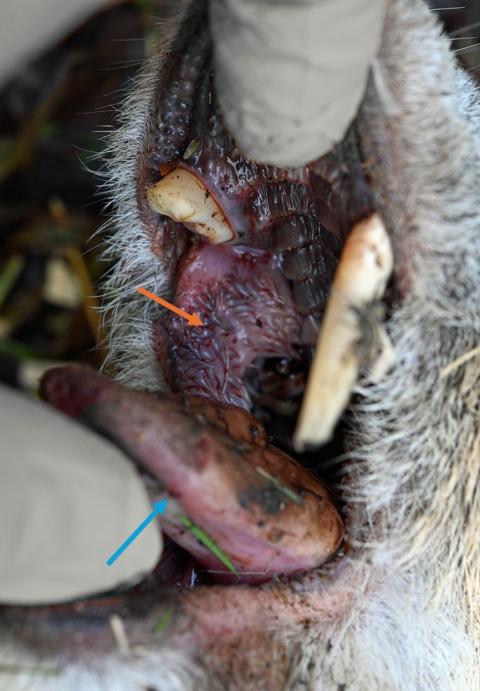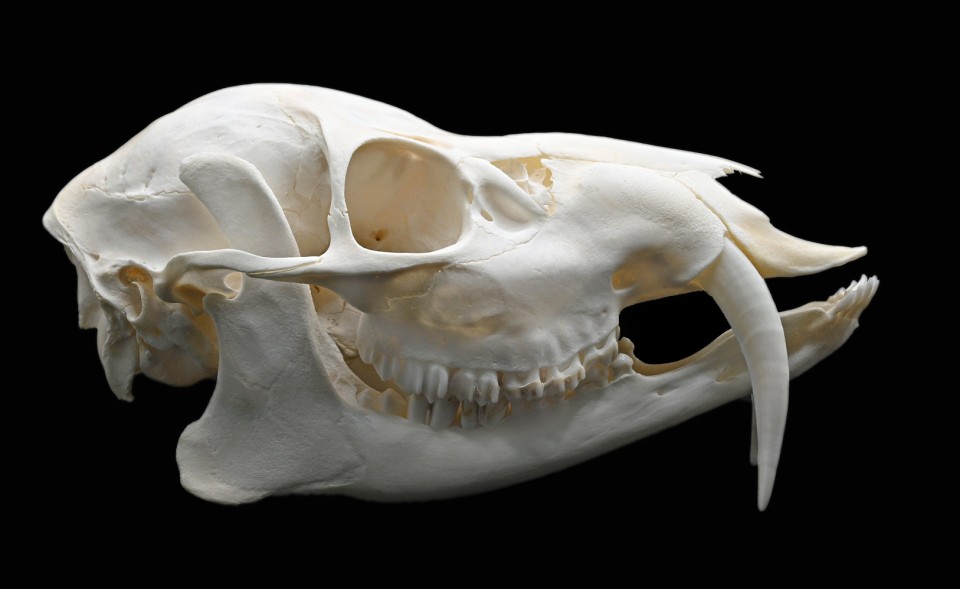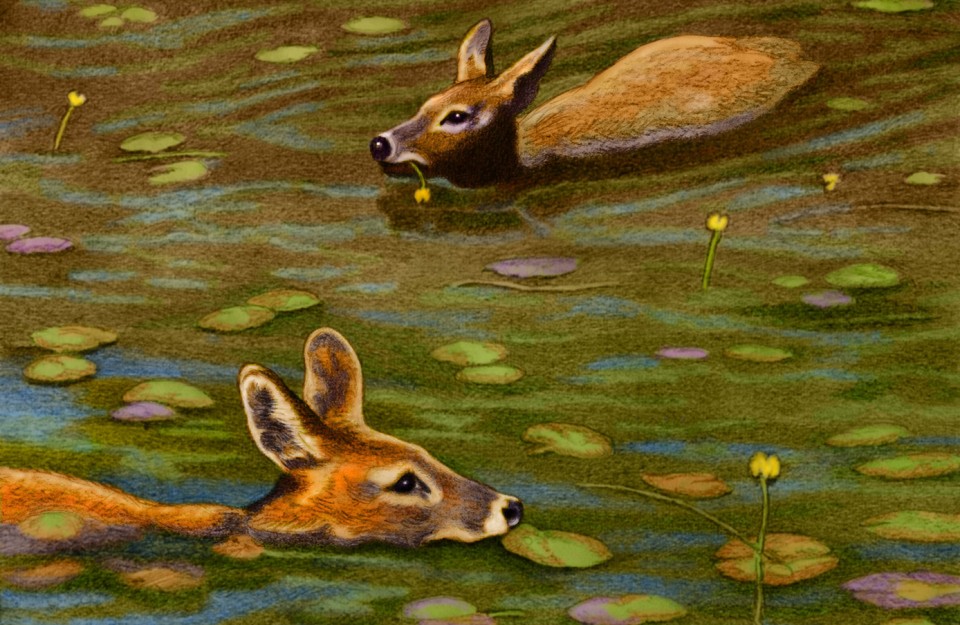Water Deer Food & Feeding - Anatomy & Behaviour
Grouping animals according to their feeding behaviour is fraught with difficulty. Deer are undeniably herbivorous, and yet there are occasional reports of them taking eggs and even live birds. Equally, there's a tendency to try and split herbivores into grazers and browsers when, in reality, most species cycle between the two according to habitat type and season. Nonetheless, in his landmark paper to Oecologia, published in 1989, Reinhold Hofmann broadly split ruminants into three categories based on a combination of the forage taken and their feeding and digestive morphology and physiology. Reinhold considered those focussing (or concentrating) on browsing trees and shrubs, such as giraffe and deer, to be concentrate feeders, those taking large volumes of grasses, forbs and other fibrous material, grazers (sometimes "roughage feeders"), sheep and cattle for example, while species in between (including goats and antelope) were intermediate feeders. There's considerable debate around how valid these categories are, but they remain in common usage today.
While deer are, broadly speaking, concentrate feeders, some are much more so than others. Roe deer (Capreolus capreolus) and Reeves' muntjac (Muntiacus reevesi), for example, are relatively inefficient at digesting cellulose and thus rely heavily on items of high digestibility and nutritional load, which typically involves browsing. Red (Cervus elaphus) and fallow deer (Dama dama), by contrast, are more likely to be found grazing. In The Deer Manager's Companion, Rory Putman considered water deer to be primarily grazers, although he and most other authors note that they seem both highly selective, taking the most nutritious parts of the plants, and adaptable, grazing or browsing depending on the locally available plant species. Similarly, in their review on the macroscopic anatomy of wild ruminants, published in the Journal of Zoology in 2010, Marcus Clauss and colleagues suggested, based on the dimensions of the reticulum relative to the rumen, that they're adapted to a high (i.e., around 50%) grass diet. Water deer are probably better considered intermediate feeders, therefore, and arguably closer to the concentrate than the roughage "end" of the spectrum.
Feeding anatomy & energy requirements

Water deer follow the standard anatomy of a ruminant digestive system. Inside the mouth is a short tongue and salivary glands that produce saliva, which not only aids chewing and swallowing, but also contains enzymes that break down starches and fats, and is critical for buffering the pH of the stomach (i.e., preventing it becoming too acidic). The parotids, serous glands that produce a watery secretion rich in bicarbonate and phosphate to buffer the rumen fluid, are the largest and most important salivary glands in relation to rumen function, and these appear large in Hydropotes. Indeed, in his 1987 paper to the Journal of Zoology, the late eminent Rowett Research Institute deer biologist Robin N.B. Kay noted that the parotid glands weighed 1.4 grams per kilogram of body weight, making them significantly heavier (relatively speaking) than those in red deer, which weigh only 0.62 grams per kilo. Heavy salivary glands are characteristic of a species that selects highly digestible food.
Andrea Meier at the University of Zurich and colleagues assessed the tongue anatomy of 65 ruminant species in a paper to the Journal of Morphology published in 2016. The tongue of water deer is about 11.5 cm (4.5 in.) long, with a tortus (fixed) and corpus (free) section. The tortus is just over 5 cm (2 in.) long and 3 cm (1.2 in.) wide, while the corpus makes up the remaining 6 cm (2.4 in.) or so and is around 2 cm (0.8 in.) at its narrowest. Overall, the anatomists note that the free portion (i.e., that from the tip to where the frenulum linguae joins on the underside) makes up about 28% of the tongue, meaning that water deer have reasonably mobile tongues, allowing grazing and browsing, but appear to be better adapted for grazing than browsing.
Like all deer, Hydropotes has a hypsodont dentition where the crowns are exceptionally tall and wear down slowly through the animal's lifetime. Data presented by Luciano Varela and Richard Fariña at the Universidad de la República in Uruguay, published in the Journal of Zoology in 2015, give the hypsodonty index (i.e., the ratio of the crown height to width of the molars) for water deer as 1.84. In other words, the molars are nearly twice as tall as they are wide.
Water deer, like all cervids, are fore-gut fermenters with stomachs compartmentalized into four chambers. Based on his dissection of a buck in 1872, William Forbes noted that, of the digestive tract villi, those of the rumen were the best developed, although, in their paper on the habitat suitability of water deer in Korea, published in Animal Cell Systems during 2016, Jihyang Jung and colleagues described how the rumen pillars (which I presume translates to the finger-like villi that project from the walls) were still relatively poorly developed compared with other deer. The researchers point to this prohibiting efficient digestion of plant carbohydrates, hence, explaining the tendency to select herbs, forbs, and young sweet grasses. Overall, however, details of the mouth and stomach structure doesn't appear to vary significantly from those of other deer, and more information on the digestive process can be found in the Deer (Overview) Feeding section.

The protracted process of digesting plant material, coupled with the water deer's selective consumption, requires a considerable amount of time to be devoted to feeding, and, at Whipsnade, Endi Zhang found that animals spent half of the day feeding (mostly grazing). In Deer of the World, Valerius Geist points out that small deer have a proportionally higher metabolic rate compared with larger species and are therefore tied to a diet of more nutritional and readily digestible foods and are likely to spend more time foraging. While he doesn't give details specifically for water deer, in his paper to the 1985 Symposia of the Zoological Society of London on animal conservation, Andrew Loudon reported that the metabolizable energy requirements for maintenance of wild deer lies between 100 and 140 kcal/kg^0.75/day, rising to 140 to 170 kcals/kg^0.75/day in late pregnancy, and further to between 240 and 270 kcals/kg^0.75/day at peak lactation. Arnold Cooke and Lynne Farrell, in their chapter in Mammals of the British Isles, published in 2008, note that water deer have a dry matter requirement of around 500 grams (17.6 oz.) per day.
Feeding behaviour
In his 2000 paper to the journal Zoological Research, Endi Zhang described the feeding behaviour of water deer as more akin to that of sheep, as they:
"... either bite the vegetation off the plant or break it off by grasping it between the teeth and dental pad and jerking the head forwards or backwards".
Coincidental to their bite mechanics being analogous to sheep, in Muntjac and Water Deer, Arnold Cooke described several adult deer that developed splayed front legs, which prevented them running efficiently, and at least one individual knelt to graze as sheep often do.
Grazing is comparatively straightforward for deer, as the species taken tend to be low growing. Browsing, by contrast, only appears to be carried out to the height to which water deer can stretch their necks and, unlike many other deer species, but akin to roe deer (Capreolus capreolus), they do not appear to stand on their hind legs to reach vegetation beyond head height. (I would be interested to hear from any readers who have observed hind leg standing by water deer and have photos or video showing the behaviour.) Additionally, in a letter to Robert Swinhoe in 1872, Howard Russell at the Imperial Customs at Chinkiang noted:
"The use of these tusks, people here declare, is for digging up roots to feed on; but as they are only possessed by the male, it is more probable that their intention is for offence and defence."
I've never observed a water deer using its tusks while feeding and, indeed, they are typically held back while grazing. I have, however, seen a couple of bucks with what appeared to be mud on their tusks. I am inclined to think the tusks were muddy from scent marking, but it's not inconceivable that they may perhaps have been employed to dig for food such as roots and bulbs, and I would be very interested to hear from anyone who has witnessed such behaviour.

When grazing, water deer walk slowly and move their head in both horizontal and vertical planes in accordance with the distribution of suitable food. In my experience they're very delicate feeders that seem to barely disturb the vegetation, and it's sometimes difficult to see on video clips what they're feeding on. When seen out in the open water deer tend to be grazing and, again in my experience, this typically involves feeding while walking a few paces, raising the head to scan for danger, before feeding and walking a few more paces. Via this sequence, they move slowly around a field. They will sometimes also feed while swimming, and there is an excellent sequence of a water deer paddling in shallow pools while feeding on sulyeon (water lily) leaves and flowers in the Wildlife in the DMZ series. Similarly, in his 2019 book, Cooke recounts the observation made to him by the Forest Officer in charge of Sandlings Forest District on the Suffolk coast who, in December 2013, following a storm surge that saw sea water encroach into Dunwich Forest, witnessed a water deer apparently browsing on flooded gorse. In the UK, however, water deer generally have little need to venture into more than a few centimetres of water to feed and tend only to swim while crossing dykes (ditches) too wide to jump.

As discussed in the Activity Patterns section, feeding chronology varies with habitat and the level of disturbance. At Woodwalton Fen in Cambridgeshire, Arnold Cooke and Lynne Farrell found peaks in feeding during the early morning and in the evening around sunset, and many other studies suggest the same. During his Ph.D. at Whipsnade, for example, Endi Zhang recorded a feeding peak in the early morning and another during the late afternoon. While there are clear peaks at dawn and dusk, water deer will nonetheless feed on and off throughout the day and night, and while information on how they spend the night is scarce, during daylight hours they seem to spend around half their active time eating.
Endi Zhang also observed that males fed for longer than females, bouts averaging 22 minutes and 16 minutes, respectively, with no significant difference according to age. Territorial bucks fed for longer than non-territorial ones, averaging 28 versus 16 minutes, at least partly because the latter's grazing was sometimes interrupted by aggressive encounters around territory boundaries. In his thesis, Zhang suggested that bucks, especially territory holders, have higher nutritional demands than females, explaining why they fed for longer. Overall, while grazing bouts didn't vary throughout the day, those in winter and early spring were longer than those in summer and autumn, although the difference was relatively small. While feeding, both bucks and does took about 1.5 seconds per bite, i.e., about 40 bites per min. (Curiously, later in his thesis Zhang wrote that the bite rate was 91 to 93 bites per minute, indicating a bite rate closer to 0.6 seconds per bite, which seems very rapid to me.) At Poyang Lake National Nature Reserve in China, Lixing Sun and colleagues have noted how bucks reduced the amount eaten during the rutting season, and this is also something I have observed in the wild in the UK. Indeed, it's not uncommon for a buck to be resting nearby a grazing female, him rising periodically to check her oestrous state, or to be following a female and scent marking while she feeds without feeding himself.
Zhang recorded that rumination started, on average (mean), 12 minutes after a deer had stopped feeding and laid down, although he doesn't give the range. Stefan Stadler observed rumination sometimes started within minutes of lying down, but was usually delayed by anywhere between 15 and 45 minutes. Rumination bouts were significantly shorter in males than females, averaging 14 and 28 minutes, respectively, although this was partly because bucks were often interrupted to drive off other males or court does. While ruminating the deer masticated at 78 to 93 chews per minute, with each bolus being manducated 50 to 55 times before it was re-swallowed. There was some indication that boluses were chewed for longer in spring (almost 58 times) than in autumn (53 times), which might reflect differences in dietary composition. Many authors have observed how deer seem very relaxed, even in a somewhat trancelike state, while ruminating, and this is something I have witnessed in water deer.
In Management of Deer and their Habitat, published in 1992, the late former RAF wing commander turned deer manager Andrew De Nahlik made an intriguing reference to water deer having "a self-regulating food intake system ... capable of dropping their winter demand for food to some 30% of summer intake immediately following the first frost". I believe De Nahlik was referring the observation by Raymond Chaplin in his captive animals.
In summer, the appetite of Chaplin's subjects was, in his words, "enormous". The deer would eat everything offered, regardless of how much hedgerow food and grazing was available, and if rations were restricted the deer became restless; they'd be foraging almost continuously when not sleeping or ruminating. Once the first cold, frosty night passed, however, appetite began to reduce and once fully established, the deer ate between half and one-third the summer intake. Chaplin points out such appetite suppression conserves energy, cutting down the time and travel involved in finding food when the weather is likely to draw heat from the body more rapidly. In spring, the first spell of warm weather reactivates appetite to coincide with the flush of new plant growth, the highly nutritious material required by females to finish foetal development and provide energy for milk production. Hence, a "false spring", where we get a brief spell of spring-like weather before winter resumes, has the potential to be very dangerous for deer with low fat reserves. Interestingly, Chaplin's account is the only one I'm aware of illustrating this behaviour. We don't know how this mechanism works, although presumably the temperature changes impact circulating hormones such as ghrelin and leptin.

We also don't know how such a highly selective species such as water deer identifies suitable food. I have watched a buck meander across rows of potato plants, picking the odd leaf here and there while ignoring other potentially suitable candidates, and deer of both sexes sniffing at and passing up fallen leaves to instead choose one nearby of the same species and, to my eye, identical in terms of colour and size. Similarly, I have watched a doe graze the undergrowth of a nettle patch with fronds around her face that appeared to largely obscure her vision, and watched (and captured on trailcameras) deer feeding at night when vision is presumably limited even despite a tapetum. As such, while vision probably plays a role in choosing food, I anticipate that smell is probably the primary identification mechanism. The comparatively long vibrissae around the mouths of the deer presumably help them navigate the understorey by touch.